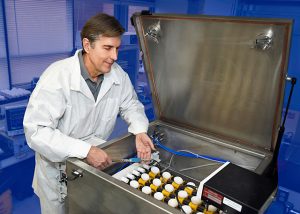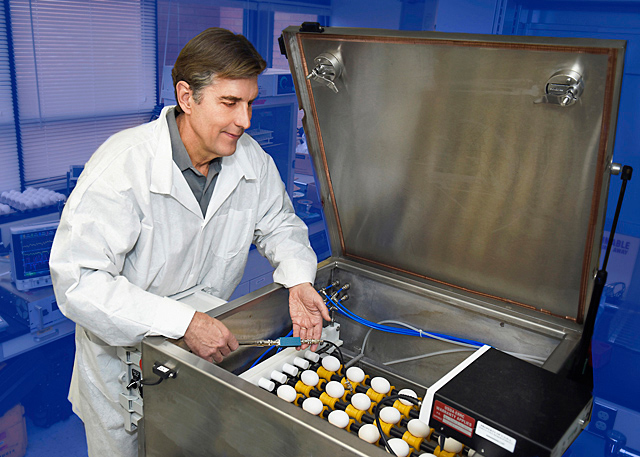 An Agricultural Research Service (ARS) scientist and his colleagues have developed a technology that rapidly pasteurizes eggs and could sharply reduce the number of illnesses caused each year by egg-borne Salmonella bacteria.
An Agricultural Research Service (ARS) scientist and his colleagues have developed a technology that rapidly pasteurizes eggs and could sharply reduce the number of illnesses caused each year by egg-borne Salmonella bacteria.
The device invented by David Geveke, a chemical engineer at the ARS Food Safety and Intervention Technologies Research Unit in Wyndmoor, Pennsylvania, uses radio frequency (RF) waves to heat eggs and reduce Salmonella without damaging egg whites.
Salmonella is associated with eating undercooked eggs or the raw eggs used in Caesar salads, eggnogs and Béarnaise and hollandaise sauces. Salmonellosis, as the infection is known, can cause diarrhea, stomach cramps and fever. Infants, preschoolers, pregnant women and the elderly are especially susceptible. Because of this, pasteurized eggs are often marketed to nursing homes and other institutional kitchens. Yet overall, less than three percent of the 74 billion fresh eggs produced and sold to U.S. consumers each year are pasteurized.
Current pasteurization methods involve immersing eggs in hot water (130 to 140 degrees Fahrenheit). The process takes about an hour and adds about $1.50 to the retail price of a dozen eggs. It also can cause proteins in the heat-sensitive egg whites to break down and coagulate during cooking.
The patented RF process is faster and ensures that the protein-rich yolk gets more heat than the egg white. It also should lower the cost of pasteurization—and the price of pasteurized eggs on store shelves. If pasteurized eggs become less expensive and more abundant, more people are likely to choose them, and fewer people will get sick, Geveke says. RF technology is already used to reduce pathogens in almonds, spices, wheat flour and other food products.
Geveke and his colleagues have published results showing that the RF treatment reduced pathogen levels by 99.999 percent, which is comparable to eggs pasteurized in hot water. The entire process also took about 20 minutes, making it almost three times faster than using hot water.
Read more about this research in the April 2017 issue of AgResearch magazine.
Image: ARS chemical engineer David Geveke measures new radio frequency equipment that he and his colleagues developed to kill Salmonella and E. coli in fresh eggs. (Photo by Joseph Sites)
Share this Post










